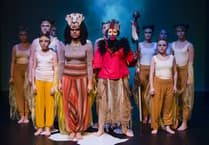The weekend saw pubs opening early and crowds gathering in Castletown, to watch whether the Lionesses would bring football home.
As the worldwide popularity of the sport continues to boom, we look back at the history of the sport in the island, and how it has evolved.
According to the book Soccer With Three Legs, by Paul Hatton and Eric Clague, the first recorded evidence of a woman’s football match taking place in the island was in 1895, when the British Ladies Football Club visited the island as part of their tour.
In 1921, more than 2,000 spectators watched an exhibition match at Falcon Cliff.
From the 1930s numerous women’s football matches took place, yet these were either charity or exhibition matches. It wasn’t until the 1960s, that the sport had more of a competitive feel, with regular knockout tournaments held at Onchan Stadium.
It was Friday, January 28, 2000, where competitive, organised football run by the Isle of Man Football Association commenced with the Floodlit Cup competition.
In its first season, the sport saw 12 teams play across two divisions.
The introduction of a women’s football development officer in 2007 further gave the sport a boost.
Paul Hatton, a sports journalist who has reported on women’s football since 2000 and co-author of Soccer With Three Legs, said: ‘I think in the first five to 10 years women’s football was very popular, but in the last decade I have seen a decline in the sport.
‘In the second season, from 2000 to 2001, you had 13 teams, and two leagues, whereas the season that has just passed, had one league and six teams, but one of those teams, towards the end of that season, were struggling to field the team.’
Asked what the reasons behind the decline were, he said: ‘I think there are numerous factors, part of it is to do with the competition for leisure time, like any past-time you are competing for people’s spare time, and it is competing against some of the more established women’s sports such as netball or hockey. Also after 10 years, maybe the novelty factor starts to wear off a bit.
‘Another reason is you have to be age 16 to compete in the senior team, whereas before it was 14 years of age.
‘I think there is also the lack of volunteers looking to put back into women’s football. I have spoken to people at junior clubs who don’t really have many female coaches looking to coach the junior girls.’
Despite the challenges, he said that in comparison to other islands, the Isle of Man has a much better structure, with Jersey only having four teams, despite having a population of more than 100,000 and Guernsey only having one team. This means that the players can only play in international matches and play off island.
He added: ‘I think in terms of representative island football, the women’s team does very well. They have just won their fifth medal at an Island Games.’
Between 2009 and 2023, the Isle of Man team won two bronzes, two silvers and one gold.
Ruby Palmer, aged 16, who was part of the Isle of Man team which came third in the Games held in Guernsey last month, spoke of the experience.
She said: ‘The Island Games was amazing, and I can’t wait to go in two years, if I am selected, but I am just going to work as hard as I can to get there, because it is the best experience I have encountered. The semi-final was disappointing but at the end of the match we all said we have got a game tomorrow.
‘I wasn’t going home empty handed, and I know that everyone else had that mentality. I won’t lie, I didn’t take that medal off for three days, so it just shows how happy I was.’
Her interest was sparked by her dad John’s passion for the sport, she said: ‘As soon as I kicked that ball down at Laxey I fell in love with the sport, and I just wanted to go down to the field every day and play.
She played at Laxey from the age of five, until she was 14. As there wasn’t a junior girls team, Ruby joined the boys team. At 16 she was old enough to join a senior women’s team, where she joined Onchan.
The formation of a Laxey women’s senior team means that she will be able to play at her home club, and it will take the number of senior women’s teams up to seven.
Ruby explained the impact of having role models in the sport: ‘I feel like when I was a kid, there wasn’t really a lot of women’s football, but ever since the Euros and just a bit before that, women’s football has exploded in the best way.
‘I feel like now there are so many role models that I can look up to and even within the island squad, I look at players and think I would love to play like you.’
Simon Elson who is the women’s and girls football development officer at the IoMFA, said: ‘Women’s football is available for everyone from junior to senior citizens, to enjoy, through the various programmes the Isle of Man FA has to offer.
‘The Weetabix Wildcats programme is for girls aged five to 11 and is non-competitive football for girls who want to give it a go for the very first time or want to play with other girls their own age.
‘The squad girls programme is for girls aged 12-14 and are keen to kick-start or continue their football journey. Squad girls’ football is designed to help develop skills and build confidence, while encouraging girls to play their way.
‘We also coordinate Manx Youth Games sessions in the build up to the event each year which offers a fantastic vehicle for girls into the sport. Sessions are organised and ran by local club coaches.
‘Girls can enjoy organised training sessions and fixtures with various junior league football clubs, and there are more IoM FA affiliated clubs offering girls football now than ever before, which is fantastic.
‘Last season the junior league had more than 250 girls playing at various clubs.
‘The FA run a programme called discover my talent ID, they are looking for players to be referred into their Lioness talent pathway.
‘Any coach in the island can recommend a female player to go to an open day, and trial to see whether they can get their foot on the ladder to become an England Lioness.
‘When a player turns 15 years old, they can play in the IoMFA under 18s mixed league.
‘At the age of 16, the girls can also play senior women’s football, and then they can progress, if selected to the island team.’
He added: ‘All the volunteers do an amazing job at the various clubs across the island, and I am so grateful that we have them.
‘We need more volunteers to step over the side lines and help in running a girls team.’
l If you are interested in getting involved in the island’s women’s football scene, as a volunteer or as a player, contact Simon Elson on [email protected] or you can find more information on the Isle of Man Football Association’s website.




